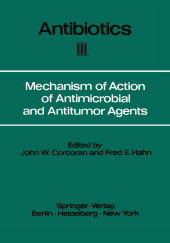 Neuerscheinungen 2012Stand: 2020-01-07 |
Schnellsuche
ISBN/Stichwort/Autor
|
Herderstraße 10
10625 Berlin
Tel.: 030 315 714 16
Fax 030 315 714 14
info@buchspektrum.de |

K. L. Arora, J. W. Corcoran, F. E. Hahn, J. F. Snell
(Beteiligte)
Mechanism of Action of Antimicrobial and Antitumor Agents
Mitarbeit: Snell, J. F.; Arora, K. L.; Herausgegeben von Corcoran, J. W.; Hahn, F. E.
Softcover reprint of the original 1st ed. 1975. 2012. xii, 744 S. XII, 742 pp. 193 figs. 244 mm
Verlag/Jahr: SPRINGER, BERLIN 2012
ISBN: 3-642-46306-1 (3642463061)
Neue ISBN: 978-3-642-46306-8 (9783642463068)
Preis und Lieferzeit: Bitte klicken
This volume is the third in the series devoted to Antibiotics initiated by Springer Verlag in 1967. The first two volumes were devoted to the Mode of Action of Antibiotics and Biogenesis, respectively and were received graciously. During the intervening years these two works have been used often by research workers and students alike and have been quoted extensively. Although a number of other excellent treatises on antibiotics have appeared, the Springer series has set a standard for thoroughness and quality that meets the need of the scientific community. It is against this background that the present Editors set about the preparation of a third volume in the Series on Antibiotics. Since the appearance of Volume I, also dealing with Mechanism of Action, tremendous strides have been made in the depth and breadth of our knowledge of molecular biology, microbial chemistry and molecular pharmacology and of their direct application to studies on the mode of action of drugs. The field of molecular biology itself was in its relative infancy during the preceding decade and the unique role played by many anti biotics in the development of our understanding of nucleic acid synthesis and function and its relationship to protein synthesis and cell physiology has led rapidly to a very precise, understanding of how many of these same antibiotics inhibit susceptible cells.
Section I. Interference with Nucleic Acid Biosynthesis.- Anthramycin.- 3?-Amino-3?-Deoxyadenosine.- Bleomycin.- Berenil: A Trypanocide with Selective Activity against Extranuclear DNA.- Camptothecin.- Chloroquine (Resochin).- Distamycin A and Netropsin.- Daunomycin (Daunorubicin) and Adriamycin and Structural Analogues: Biological Activity and Mechanism of Action.- Edeines.- Ethidium and Propidium.- Kanchanomycin.- Nalidixic Acid - Mode of Action.- Olivomycin, Chromomycin, and Mithramycin.- Quinacrine and Other Acridines.- Quinoxaline Antibiotics.- Rifamycins and Other Ansamycins.- Sibiromycin.- Thiaxanthenones: Miracil D and Hycanthone.- Addendum.- Trimethoprim and Pyrimethamine.- Section II. Interference with Protein Biosynthesis.- Althiomycin.- Aurintricarboxylic Acid. A Non-Antibiotic Organic Molecule that Inhibits Protein Synthesis.- Aminoglycoside Antibiotics.- Borrelidin.- Chloramphenicol.- The Erythromycins.- Emetine and Related Alkaloids.- Fusidic Acid.- Gougerotin.- The Macrolide Antibiotics.- Micrococcin and Micrococcin.- Mikamycin.- Pactamycin.- Primaquine.- The Streptogramin Family of Antibiotics.- Streptomycin, Dihydrostreptomycin, and the Gentamicins.- The Thiostrepton Group of Antibiotics.- Section III. Interference with Cell Wall/Membrane Biosynthesis, Specific Enzyme Systems and Those in Which Mode of Action Not Known with Certainty.- Berberine.- Boromycin.- Colicins 1972.- Griseofulvin.- Irehdiamine and Malouetine.- Isonicotinic Acid Hydrazide.- Sideromycins.- Sulfonamides and Sulfones.- Suramin.- Vancomycin.


